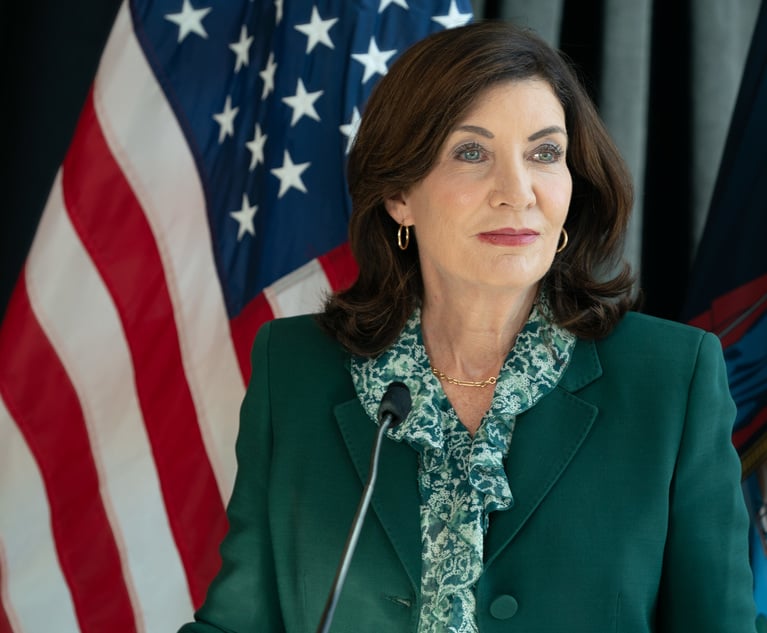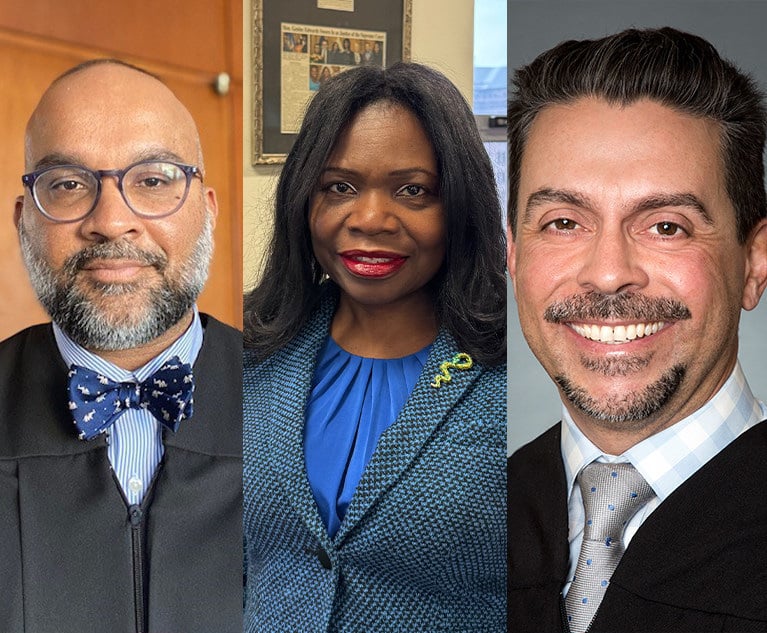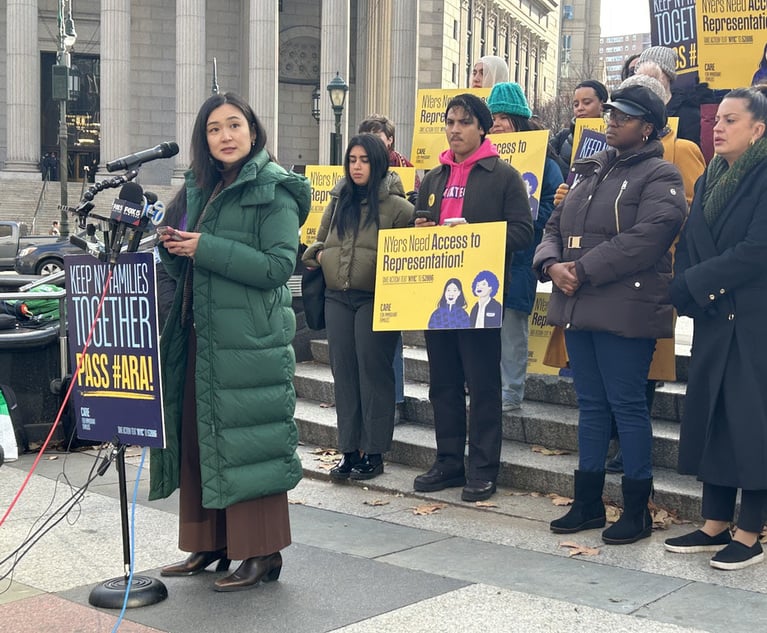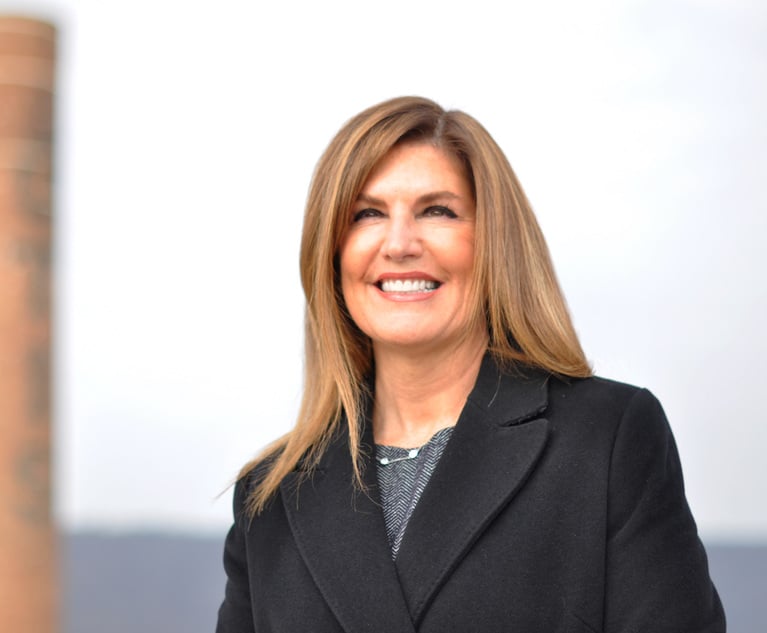 Michael B. Gerrard and Edward McTiernan
Michael B. Gerrard and Edward McTiernanNew York's New Statute on Siting Renewable Energy Facilities
In their Environmental Law Column, Michael B. Gerrard and Edward McTiernan discuss a recently enacted law that completely revamps the process under which large-scale renewable energy facilities and associated transmission lines receive state and local approvals.
May 13, 2020 at 12:15 PM
9 minute read
As part of a massive budget bill signed into law by Gov. Andrew Cuomo on April 3, New York has adopted the Accelerated Renewable Energy Growth and Community Benefit Act (AREGCBA). It completely revamps the process under which large-scale renewable energy facilities and associated transmission lines receive state and local approvals.
A new renewables siting process was essential to achieving the goals of New York's landmark Climate Leadership and Community Protection Act, enacted in July. That law, discussed in this column on July 11, 2019, requires that by 2030, 70% of New York's electric power demand be met by renewables, up from the current 29%. The climate law also mandates that by 2040, 100% of the power come from zero emissions sources—basically renewables and nuclear. Nuclear had supplied 32%, but that number is shrinking—one unit of the Indian Point plant in Westchester County shut down permanently on April 30, 2020; the other remaining unit is closing in 2021, and the four smaller nuclear plants near Lake Ontario are aging and (despite heavy subsidies) may not make it to 2040.
The new renewables will mostly be wind and solar, perhaps with some geothermal and hydropower. It is possible that a new safe and affordable nuclear technology will emerge in the next few decades but no one can count on this.
Back in 1972 New York enacted a power plant siting law for steam-electric facilities. It went through various iterations; the current version was enacted in 2011 and is called Article 10. It aimed to allow the faster and easier permitting of renewable energy facilities. It has been a miserable failure. In theory this is supposed to be a 12-month process from complete application to decision, with just modest amounts of work at the front end and at the back end, and with state override of unreasonable local controls. In practice, it has taken years for projects to get to the starting gate, and there have been long delays in obtaining final construction approvals once the siting certificate was granted. The state has been very reluctant to exercise its authority to override local laws, fearing a political backlash. So far six wind projects have been approved under this process; 16 wind projects and 40 solar projects are in the queue. Some of these are new but some go back to 2015. One of the recently approved wind projects had been working through the Article 10 process for eight years before getting its certificate. Not a single renewable project approved under Article 10 is operational yet.
New renewable energy projects with greater than 25 megawatts (MW) of capacity will go through the AREGCBA process; those between 20 MW and 25 MW may opt in. Projects that are already in the Article 10 process may stay there or may opt in to AREGCBA. The small projects that do not proceed under the new law are still subject to the State Environmental Quality Review Act.
|New Siting Process
The new law is Part JJJ of the budget law, Chapter 58 of the Session Laws of 2020, and most of it will be codified in §94-c of the Executive Law. It creates a new Office of Renewable Energy Siting (ORES) within the Department of State. ORES has one year—until April 3, 2021—to hold four public hearings across the state, consult with other state agencies, and then establish a set of uniform standards and conditions for designing, engineering and operating covered facilities, in order to avoid or minimize any adverse environmental impacts. That way these requirements will not have to be hammered out separately for each project. Until those standards are final, applications will need to resemble those under Article 10.
Applications must be submitted to ORES; no other state or local entity has permitting authority over these projects (with a minor exception for federally-delegated permits), though applicants must notify and consult with the municipality where a project is located by the time they apply. ORES must determine whether the application is complete within 60 days. The time-consuming requirements under Article 10 for a public involvement plan and preliminary scoping statement are eliminated. ORES must develop draft permit conditions in consultation with other state agencies and publish them within 60 days after the application is deemed complete. That is followed by a 60-day period during which the public, municipalities and others may comment. If any of the comments raise a "substantive and significant issue," ORES will hold an adjudicatory hearing. No separate siting board will be convened. ORES must make its final decision on a permit application within one year of deeming an application complete; if it misses that deadline the permit is issued by default. ORES has just six months to act on projects that are sited on "existing or abandoned commercial use" locations, such as brownfields, landfills and abandoned properties.
Parties challenging an ORES approval have 90 days to petition the Appellate Division for judicial review. The new law limits the scope of this review to certain specified issues.
As another way to accelerate development, the new law authorizes the New York State Energy Research and Development Authority (NYSERDA) to identify sites for renewable energy projects at locations that are "difficult to develop" such as brownfields and landfills. NYSERDA can then buy or otherwise acquire the right to use this land; obtain the permits to build there; and transfer the build-ready sites to developers selected after a competitive bidding process. Special precautions are imposed to guard against negative impacts on environmental justice communities.
|Municipal Role
The role of municipalities in approving renewables has been especially controversial. Several upstate municipalities have imposed moratoria or crippling limits on large wind or solar facilities. Under Article 10, the state could override local restrictions but it never did (except for a few minor rules on setbacks and the like, or on narrow procedural grounds). Local opposition killed many projects, or dissuaded developers from even trying to build in places with hostile local boards.
Under AREGCBA, an applicant must consult with the municipality where the project is located before filing its application. Once ORES determines the application to be complete, the municipality has 60 days to notify ORES whether the project complies with local laws concerning the environment and public health and safety. If the municipality declares noncompliance, ORES must hold a hearing—either an adjudicatory hearing if "substantive and significant issues" are raised, or, if not, a public statement hearing.
Projects must adhere to all local laws unless ORES finds them to be "unreasonably burdensome." This is the same standard as under Article 10. However, under Article 10 that standard was applied "in view of the existing technology or the needs of or costs to ratepayers." Instead AREGCBA provides the burdens of the local laws must be considered in view of the goals of the New York climate law and the environmental benefits of the projects. This appears designed to make it easier for the state to override local restrictions.
A sweetener for municipalities is that final permits must include host community benefits. The Public Service Commission (PSC) is required to start a proceeding to identify utility bill discounts or other benefits to utility customers in communities that host renewable facilities. The host community and the applicant may also agree on other benefits.
Though AREGCBA as enacted by the legislature is mostly the same as the bill that Governor Cuomo proposed, it does not include his proposals to clarify the amount of payment in lieu of taxes (PILOT) that projects must pay, or the way that the real property value for solar and wind projects is assessed.
Applicants must pay a fee of $1,000 per megawatt into a special account for the participation of municipalities and community intervenors in the public comment periods and hearings. ORES may collect additional fees to cover its costs of reviewing and processing applications.
AREGCBA also establishes an Endangered and Threatened Species Mitigation Bank Fund to be administered by the Department of Environmental Conservation. Projects that have negative environmental impacts may mitigate them by paying into that fund for offsite mitigation projects that "facilitate a net conservation benefit to endangered and threatened species potentially impacted" by the project.
|Transmission and Power Grid
One of the major constraints on large-scale renewables is that they are often distant from where the power is needed, and transmission lines must be built to connect generation with load. AREGCBA addresses this in four ways.
First, the new law requires the Department of Public Service to undertake a statewide study of the power grid, and to identify the necessary upgrades to bulk transmission and local transmission systems. The initial findings and recommendations are due by Dec. 29, 2020. Within 60 days after that, the PSC must start proceedings to implement the recommendations. All this will be done in conjunction with the utilities and the operators of the transmission systems.
Second, the New York Power Authority is authorized to build the recommended projects, on its own or in conjunction with others.
Third, the new law amends Article VII of the Public Service Law, which governs major electric transmission facilities. The amendment requires the PSC to make decisions on complete applications within one year; current law has no time limits. An even faster process (nine months) is provided for transmission projects within existing rights-of-way, or without significant adverse environmental impacts.
Fourth, lines that are less than 10 miles in length connecting new renewable generators to the grid will be processed under the generator's approval process, and will not need to go through the Article VII process at all.
|Conclusion
Both AREGCBA and the new climate law have ambitious targets and aggressive timelines. The pandemic makes meeting them even more challenging. However, the pandemic also demonstrates that the dire predictions of scientists must be heeded. The climate crisis still looms as an even greater threat to society than the virus, and every effort must be made to keep to the deadlines that the legislature has wisely imposed.
Michael B. Gerrard is a professor and Faculty Director of the Sabin Center for Climate Change Law at Columbia Law School, and Senior Counsel to Arnold & Porter. Edward McTiernan is a partner with Arnold & Porter and former General Counsel of the New York State Department of Environmental Conservation.
This content has been archived. It is available through our partners, LexisNexis® and Bloomberg Law.
To view this content, please continue to their sites.
Not a Lexis Subscriber?
Subscribe Now
Not a Bloomberg Law Subscriber?
Subscribe Now
NOT FOR REPRINT
© 2024 ALM Global, LLC, All Rights Reserved. Request academic re-use from www.copyright.com. All other uses, submit a request to [email protected]. For more information visit Asset & Logo Licensing.
You Might Like
View All
Hochul Vetoes 'Grieving Families' Bill, Faulting a Lack of Changes to Suit Her Concerns

Court System Names New Administrative Judges for New York City Courts in Leadership Shakeup
3 minute read

Retired Judge Susan Cacace Elected Westchester DA in Win for Democrats
Law Firms Mentioned
Trending Stories
- 1Wholesale Real Estate Transaction Transparency and Protection Act Takes Effect Jan. 4: What You Need to Know
- 2Decision of the Day: 'Attorney's Eyes Only' Protective Order Denied; Good Cause Not Demonstrated
- 3The Crypto Guys Seem to Like Paul Atkins as a New SEC Commissioner, but Will He Be Good for the Securities Industry?
- 4Lawsuits, AI Accuracy and Debt: Legal Tech Companies that Ran Into Trouble in 2024
- 5Preemptive Litigation: A Potential Approach for a Precise Situation
Who Got The Work
Michael G. Bongiorno, Andrew Scott Dulberg and Elizabeth E. Driscoll from Wilmer Cutler Pickering Hale and Dorr have stepped in to represent Symbotic Inc., an A.I.-enabled technology platform that focuses on increasing supply chain efficiency, and other defendants in a pending shareholder derivative lawsuit. The case, filed Oct. 2 in Massachusetts District Court by the Brown Law Firm on behalf of Stephen Austen, accuses certain officers and directors of misleading investors in regard to Symbotic's potential for margin growth by failing to disclose that the company was not equipped to timely deploy its systems or manage expenses through project delays. The case, assigned to U.S. District Judge Nathaniel M. Gorton, is 1:24-cv-12522, Austen v. Cohen et al.
Who Got The Work
Edmund Polubinski and Marie Killmond of Davis Polk & Wardwell have entered appearances for data platform software development company MongoDB and other defendants in a pending shareholder derivative lawsuit. The action, filed Oct. 7 in New York Southern District Court by the Brown Law Firm, accuses the company's directors and/or officers of falsely expressing confidence in the company’s restructuring of its sales incentive plan and downplaying the severity of decreases in its upfront commitments. The case is 1:24-cv-07594, Roy v. Ittycheria et al.
Who Got The Work
Amy O. Bruchs and Kurt F. Ellison of Michael Best & Friedrich have entered appearances for Epic Systems Corp. in a pending employment discrimination lawsuit. The suit was filed Sept. 7 in Wisconsin Western District Court by Levine Eisberner LLC and Siri & Glimstad on behalf of a project manager who claims that he was wrongfully terminated after applying for a religious exemption to the defendant's COVID-19 vaccine mandate. The case, assigned to U.S. Magistrate Judge Anita Marie Boor, is 3:24-cv-00630, Secker, Nathan v. Epic Systems Corporation.
Who Got The Work
David X. Sullivan, Thomas J. Finn and Gregory A. Hall from McCarter & English have entered appearances for Sunrun Installation Services in a pending civil rights lawsuit. The complaint was filed Sept. 4 in Connecticut District Court by attorney Robert M. Berke on behalf of former employee George Edward Steins, who was arrested and charged with employing an unregistered home improvement salesperson. The complaint alleges that had Sunrun informed the Connecticut Department of Consumer Protection that the plaintiff's employment had ended in 2017 and that he no longer held Sunrun's home improvement contractor license, he would not have been hit with charges, which were dismissed in May 2024. The case, assigned to U.S. District Judge Jeffrey A. Meyer, is 3:24-cv-01423, Steins v. Sunrun, Inc. et al.
Who Got The Work
Greenberg Traurig shareholder Joshua L. Raskin has entered an appearance for boohoo.com UK Ltd. in a pending patent infringement lawsuit. The suit, filed Sept. 3 in Texas Eastern District Court by Rozier Hardt McDonough on behalf of Alto Dynamics, asserts five patents related to an online shopping platform. The case, assigned to U.S. District Judge Rodney Gilstrap, is 2:24-cv-00719, Alto Dynamics, LLC v. boohoo.com UK Limited.
Featured Firms
Law Offices of Gary Martin Hays & Associates, P.C.
(470) 294-1674
Law Offices of Mark E. Salomone
(857) 444-6468
Smith & Hassler
(713) 739-1250






